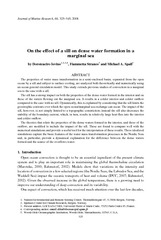On the effect of a sill on dense water formation in a marginal sea
Journal article
Permanent lenke
https://hdl.handle.net/1956/3220Utgivelsesdato
2008-05Metadata
Vis full innførselSamlinger
Originalversjon
https://doi.org/10.1357/002224008786176016Sammendrag
The properties of water mass transformation in a semi-enclosed basin, separated from the open ocean by a sill and subject to surface cooling, are analyzed both theoretically and numerically using an ocean general circulation model. This study extends previous studies of convection in a marginal sea to the case with a sill. The sill has a strong impact on both the properties of the dense water formed in the interior and on those of the waters flowing out the marginal sea. It results in a colder interior and colder outflow compared to the case with no sill. Dynamically, this is explained by considering that the sill limits the geostrophic contours over which the open ocean/marginal sea exchange can occur. The impact of the sill, however, is not simply limited to a topographic constriction; instead the sill also decreases the stability of the boundary current, which, in turn, results in relatively large heat flux into the interior and colder outflow. The theories that relate the properties of the dense waters formed in the interior, and those of the outflow, are modified to include the impact of the sill. These are found to compare well with the numerical simulations and provide a useful tool for the interpretation of these results. These idealized simulations capture the basic features of the water mass transformation processes in the Nordic Seas and, in particular, provide a dynamical explanation for the difference between the dense waters formed and the source of the overflows water.
